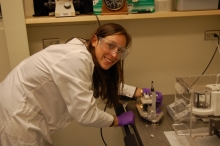
Major:
University:
Mentor(s):
Faculty Sponsor(s):
Faculty Sponsor's Department(s):
Project Title:
Project Description:
The effects of surface nanotopography must be considered in a variety of areas such as nanotechnology and cellular biology. Therefore it is important to create surface models with controlled topographies in order to study these effects. Polymeric nanoparticle monolayers can be created using convective assembly, a method where a motor is used to spread a nanoparticle containing solution along a mica surface at a constant rate. It is hypothesized that when creating polymeric nanoparticle monolayers using convective assembly RMS roughness can be controlled by varying deposition speed and initial solution concentration. It is further hypothesized that once heated, the particles will fuse to form a smoother surface. To do this, 120 nm and 490 nm diameter polystyrene particle solutions of varied concentrations were laid at different deposition speeds. Atomic Force Microscopy was used to analyze each surface by calculating the RMS roughness. It was found that while increased concentration at a constant deposition speed generated slightly lower RMS roughness values, RMS roughness values changed more drastically with constant concentration and a decreased deposition speed. These findings were consistent with both the 490 nm diameter and 120 nm diameter particle surfaces. Thus, deposition speed provides a more fine tuned control over surface roughness than altering solution concentration when using convective assembly to create polymeric nanoparticle monolayers. This information was used to create homogeneous polymeric nanoparticle monolayers. Once heated, the particles deformed and partially fused, forming smoother surfaces. Hopefully these controlled model surfaces will allow for further research in areas such as the effects of topography on cell growth.
